UNITED STATES
SECURITIES AND EXCHANGE COMMISSION
WASHINGTON, D.C. 20549
SCHEDULE 14A
Proxy Statement Pursuant to Section 14(a) of the
Securities Exchange Act of 1934
(Amendment No. )
Filed by the Registrant ☒ Filed by a Party other than the Registrant ☐
Check the appropriate box:
| ☐ | Preliminary Proxy Statement |
| ☐ | Confidential, for Use of the Commission Only (as permitted by Rule 14a-6(e)(2)) |
| ☐ | Definitive Proxy Statement |
| ☒ | Definitive Additional Materials |
| ☐ | Soliciting Material Pursuant to § 240.14a-12 |
Time Warner Inc.
(Name of Registrant as Specified In Its Charter)
(Name of Person(s) Filing Proxy Statement, if other than the Registrant)
Payment of Filing Fee (Check the appropriate box):
| | | | |
| ☒ | | No fee required. |
| |
| ☐ | | Fee computed on table below per Exchange Act Rules 14a-6(i)(1) and 0-11. |
| | |
| | (1) | | Title of each class of securities to which transaction applies: |
| | | | |
| | (2) | | Aggregate number of securities to which transaction applies: |
| | | | |
| | (3) | | Per unit price or other underlying value of transaction computed pursuant to Exchange Act Rule 0-11 (set forth the amount on which the filing fee is calculated and state how it was determined): |
| | | | |
| | (4) | | Proposed maximum aggregate value of transaction: |
| | | | |
| | (5) | | Total fee paid: |
| | | | |
| |
| ☐ | | Fee paid previously with preliminary materials. |
| |
| ☐ | | Check box if any part of the fee is offset as provided by Exchange Act Rule 0-11(a)(2) and identify the filing for which the offsetting fee was paid previously. Identify the previous filing by registration statement number, or the Form or Schedule and the date of its filing. |
| | |
| | (1) | | Amount Previously Paid: |
| | | | |
| | (2) | | Form, Schedule or Registration Statement No.: |
| | | | |
| | (3) | | Filing Party: |
| | | | |
| | (4) | | Date Filed: |
| | | | |
Explanatory Note: As part of Time Warner Inc.’s regular ongoing engagement with shareholders, Time Warner is planning to have a number of meetings with shareholders. The attached Proxy Statement Summary is intended to facilitate discussions at those meetings and presents information regarding Time Warner’s business, performance, pending merger with AT&T Inc., executive compensation programs (including a transaction-related compensation program), director nominees, corporate responsibility and sustainability practices, and governance practices taken from Time Warner’s Proxy Statement for its 2017 Annual Meeting of Shareholders.
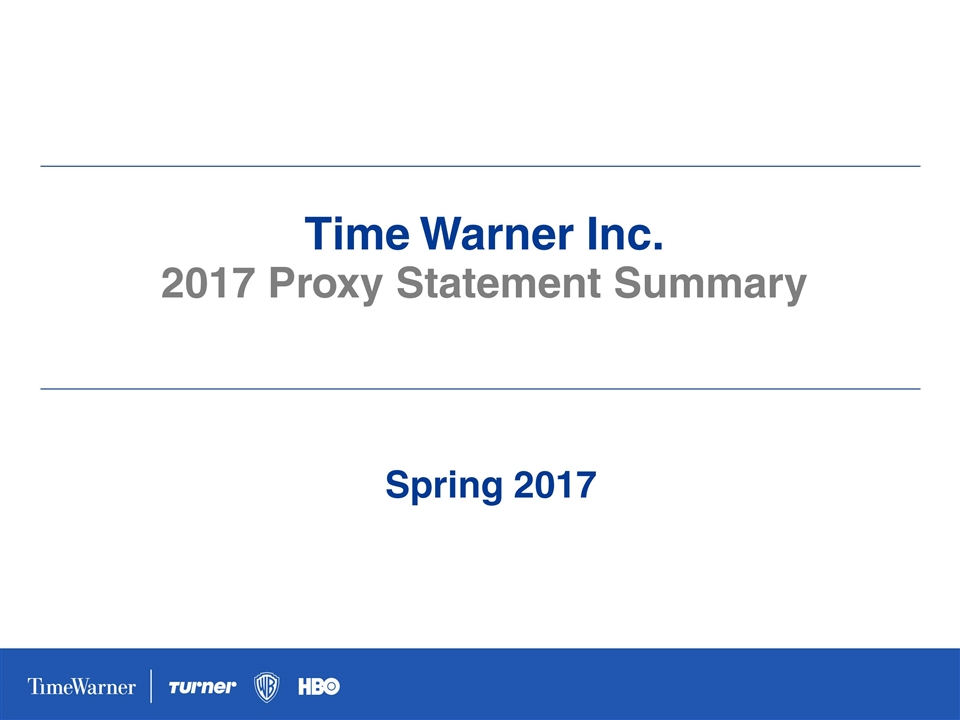
Spring 2017 Time Warner Inc. 2017 Proxy Statement Summary
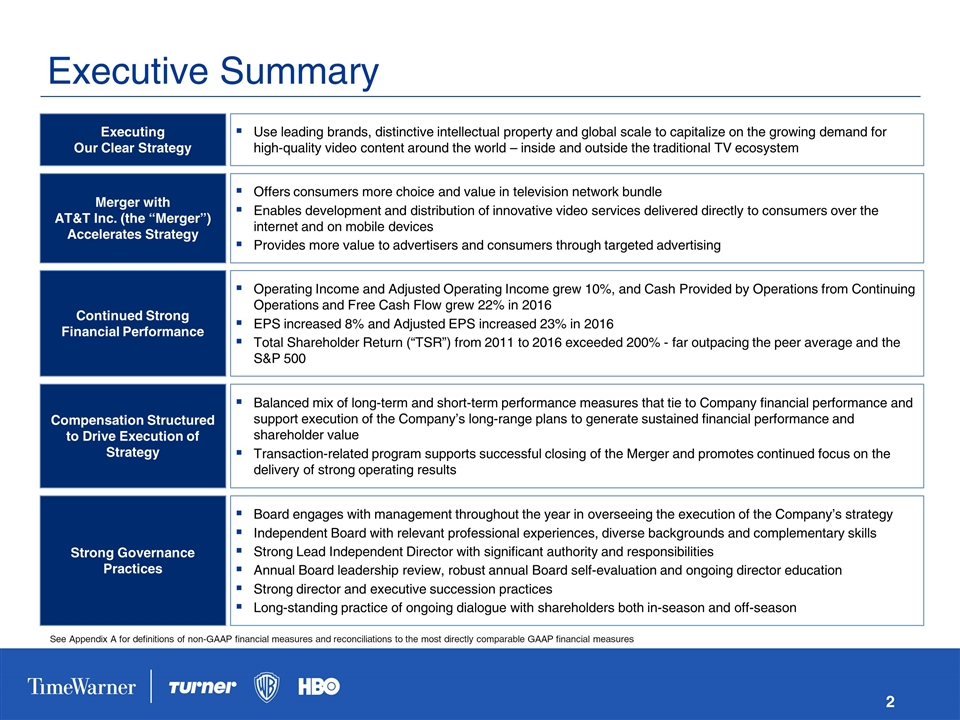
Executive Summary Merger with AT&T Inc. (the “Merger”) Accelerates Strategy Offers consumers more choice and value in television network bundle Enables development and distribution of innovative video services delivered directly to consumers over the internet and on mobile devices Provides more value to advertisers and consumers through targeted advertising Compensation Structured to Drive Execution of Strategy Balanced mix of long-term and short-term performance measures that tie to Company financial performance and support execution of the Company’s long-range plans to generate sustained financial performance and shareholder value Transaction-related program supports successful closing of the Merger and promotes continued focus on the delivery of strong operating results Strong Governance Practices Board engages with management throughout the year in overseeing the execution of the Company’s strategy Independent Board with relevant professional experiences, diverse backgrounds and complementary skills Strong Lead Independent Director with significant authority and responsibilities Annual Board leadership review, robust annual Board self-evaluation and ongoing director education Strong director and executive succession practices Long-standing practice of ongoing dialogue with shareholders both in-season and off-season Executing Our Clear Strategy Use leading brands, distinctive intellectual property and global scale to capitalize on the growing demand for high-quality video content around the world – inside and outside the traditional TV ecosystem Continued Strong Financial Performance Operating Income and Adjusted Operating Income grew 10%, and Cash Provided by Operations from Continuing Operations and Free Cash Flow grew 22% in 2016 EPS increased 8% and Adjusted EPS increased 23% in 2016 Total Shareholder Return (“TSR”) from 2011 to 2016 exceeded 200% - far outpacing the peer average and the S&P 500 See Appendix A for definitions of non-GAAP financial measures and reconciliations to the most directly comparable GAAP financial measures
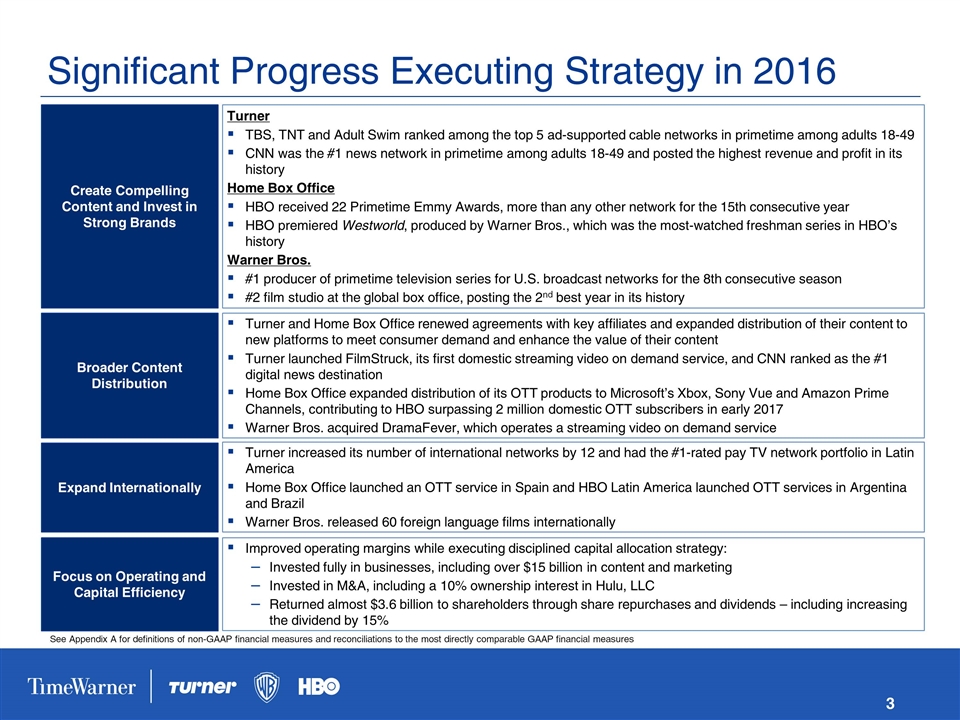
Significant Progress Executing Strategy in 2016 Create Compelling Content and Invest in Strong Brands Turner TBS, TNT and Adult Swim ranked among the top 5 ad-supported cable networks in primetime among adults 18-49 CNN was the #1 news network in primetime among adults 18-49 and posted the highest revenue and profit in its history Home Box Office HBO received 22 Primetime Emmy Awards, more than any other network for the 15th consecutive year HBO premiered Westworld, produced by Warner Bros., which was the most-watched freshman series in HBO’s history Warner Bros. #1 producer of primetime television series for U.S. broadcast networks for the 8th consecutive season #2 film studio at the global box office, posting the 2nd best year in its history Broader Content Distribution Turner and Home Box Office renewed agreements with key affiliates and expanded distribution of their content to new platforms to meet consumer demand and enhance the value of their content Turner launched FilmStruck, its first domestic streaming video on demand service, and CNN ranked as the #1 digital news destination Home Box Office expanded distribution of its OTT products to Microsoft’s Xbox, Sony Vue and Amazon Prime Channels, contributing to HBO surpassing 2 million domestic OTT subscribers in early 2017 Warner Bros. acquired DramaFever, which operates a streaming video on demand service Expand Internationally Turner increased its number of international networks by 12 and had the #1-rated pay TV network portfolio in Latin America Home Box Office launched an OTT service in Spain and HBO Latin America launched OTT services in Argentina and Brazil Warner Bros. released 60 foreign language films internationally Focus on Operating and Capital Efficiency Improved operating margins while executing disciplined capital allocation strategy: Invested fully in businesses, including over $15 billion in content and marketing Invested in M&A, including a 10% ownership interest in Hulu, LLC Returned almost $3.6 billion to shareholders through share repurchases and dividends – including increasing the dividend by 15% See Appendix A for definitions of non-GAAP financial measures and reconciliations to the most directly comparable GAAP financial measures
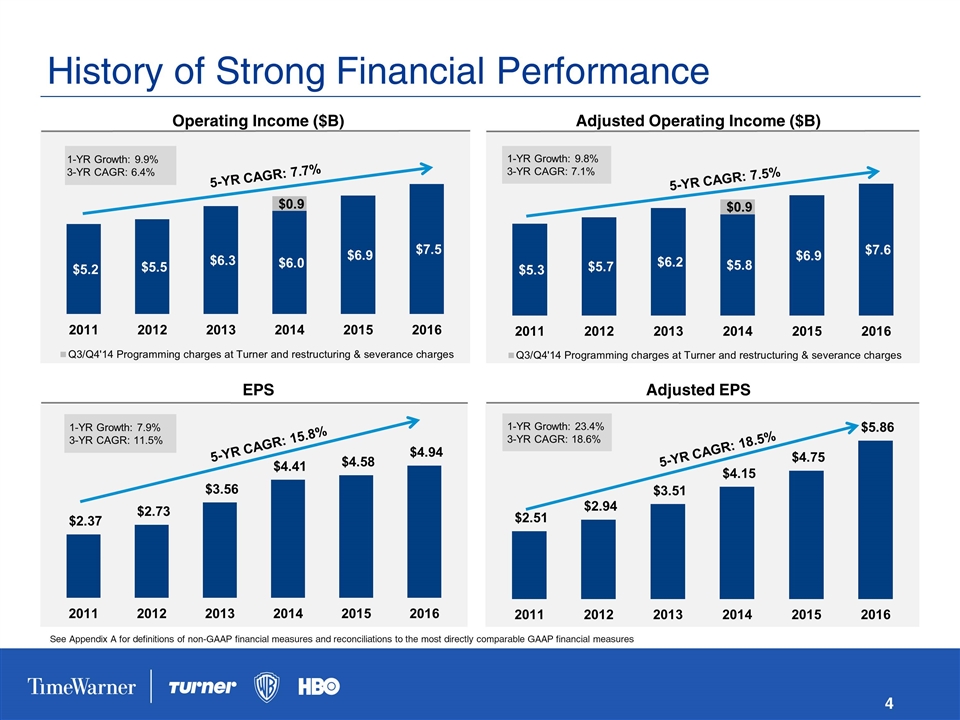
5-YR CAGR: 7.7% 1-YR Growth: 9.9% 3-YR CAGR: 6.4% Operating Income ($B) Adjusted EPS EPS History of Strong Financial Performance See Appendix A for definitions of non-GAAP financial measures and reconciliations to the most directly comparable GAAP financial measures 5-YR CAGR: 7.5% 1-YR Growth: 9.8% 3-YR CAGR: 7.1% Adjusted Operating Income ($B) 5-YR CAGR: 18.5% 1-YR Growth: 23.4% 3-YR CAGR: 18.6% 5-YR CAGR: 15.8% 1-YR Growth: 7.9% 3-YR CAGR: 11.5%
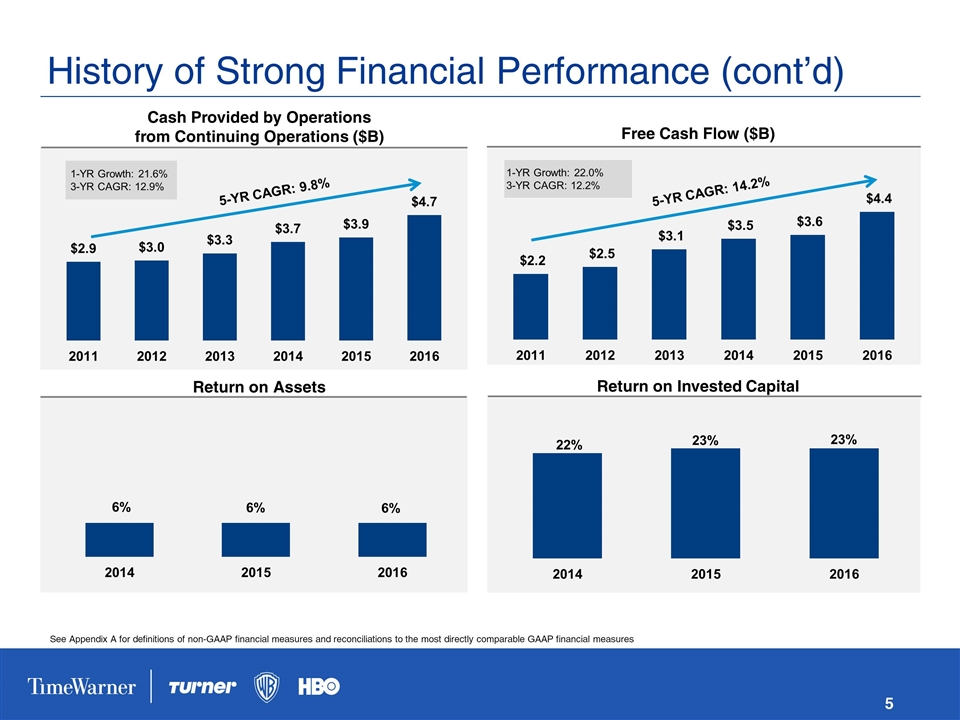
5-YR CAGR: 9.8% 1-YR Growth: 21.6% 3-YR CAGR: 12.9% Free Cash Flow ($B) Return on Invested Capital Cash Provided by Operations from Continuing Operations ($B) Return on Assets History of Strong Financial Performance (cont’d) See Appendix A for definitions of non-GAAP financial measures and reconciliations to the most directly comparable GAAP financial measures
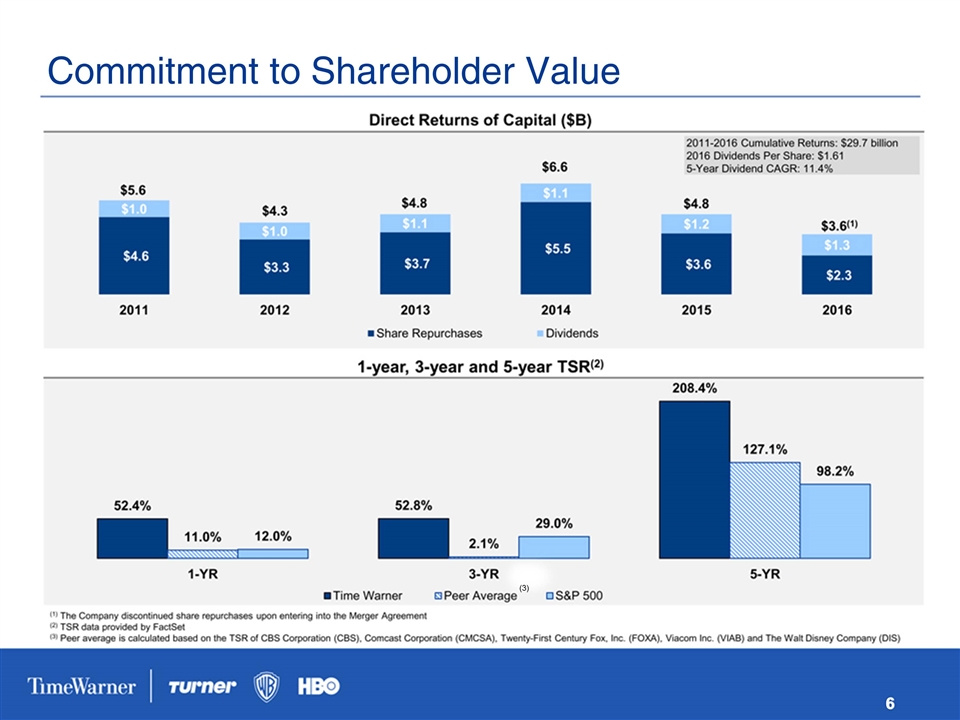
Commitment to Shareholder Value (3)

Merger with AT&T – Expected to Close Before Year-End 2017 In October 2016, Time Warner entered into an Agreement and Plan of Merger with AT&T (the “Merger Agreement”), pursuant to which the Company will be acquired by AT&T in a stock-and-cash transaction The Board considered a number of factors before unanimously approving the Merger Agreement, including how the Merger – by combining the Company’s content with AT&T’s distribution capabilities – would accelerate and reduce the risk in the execution of the Company’s strategy by: Offering consumers more choice and value in television network bundles, Developing and launching innovative video services delivered directly to consumers over the internet and on mobile devices, and Providing more value to advertisers and consumers through targeted advertising Time Warner contacted shareholders representing over 50% of the Company’s outstanding shares regarding the Merger in connection with the special meeting of shareholders Time Warner’s shareholders approved the Merger at a special meeting held on February 15, 2017, with about 79% of Time Warner’s outstanding shares, and more than 99% of the votes cast, voting in favor of the adoption of the Merger Agreement The Merger is conditioned on the receipt of certain antitrust reviews and approvals and other required regulatory consents
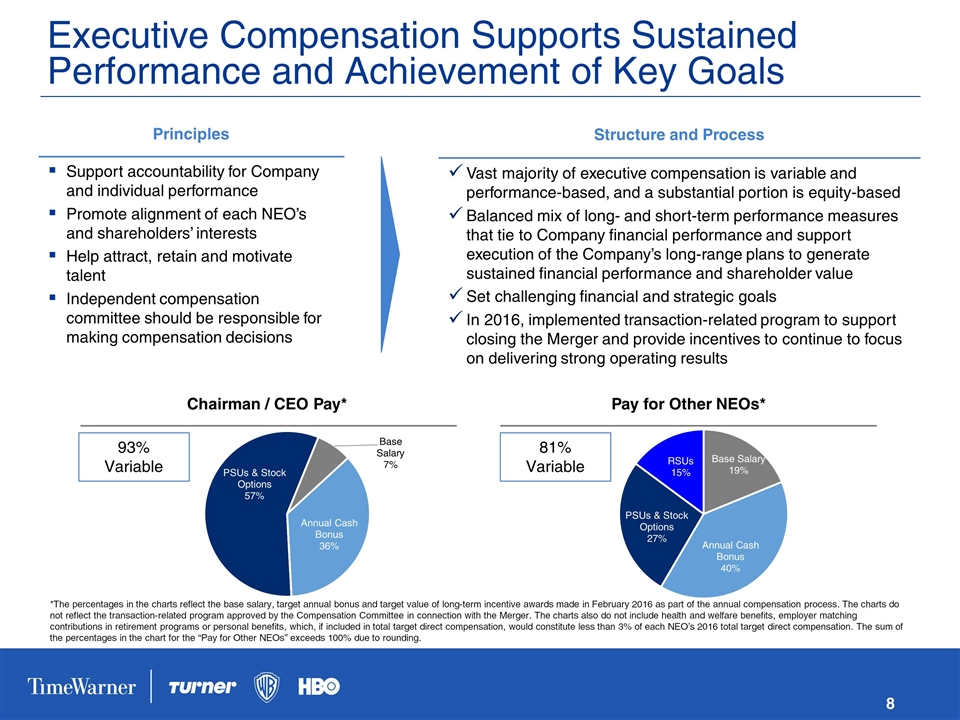
Executive Compensation Supports Sustained Performance and Achievement of Key Goals Pay for Other NEOs* 93% Variable 81% Variable *The percentages in the charts reflect the base salary, target annual bonus and target value of long-term incentive awards made in February 2016 as part of the annual compensation process. The charts do not reflect the transaction-related program approved by the Compensation Committee in connection with the Merger. The charts also do not include health and welfare benefits, employer matching contributions in retirement programs or personal benefits, which, if included in total target direct compensation, would constitute less than 3% of each NEO’s 2016 total target direct compensation. The sum of the percentages in the chart for the “Pay for Other NEOs” exceeds 100% due to rounding. Principles Support accountability for Company and individual performance Promote alignment of each NEO’s and shareholders’ interests Help attract, retain and motivate talent Independent compensation committee should be responsible for making compensation decisions Chairman / CEO Pay* Vast majority of executive compensation is variable and performance-based, and a substantial portion is equity-based Balanced mix of long- and short-term performance measures that tie to Company financial performance and support execution of the Company’s long-range plans to generate sustained financial performance and shareholder value Set challenging financial and strategic goals In 2016, implemented transaction-related program to support closing the Merger and provide incentives to continue to focus on delivering strong operating results Structure and Process
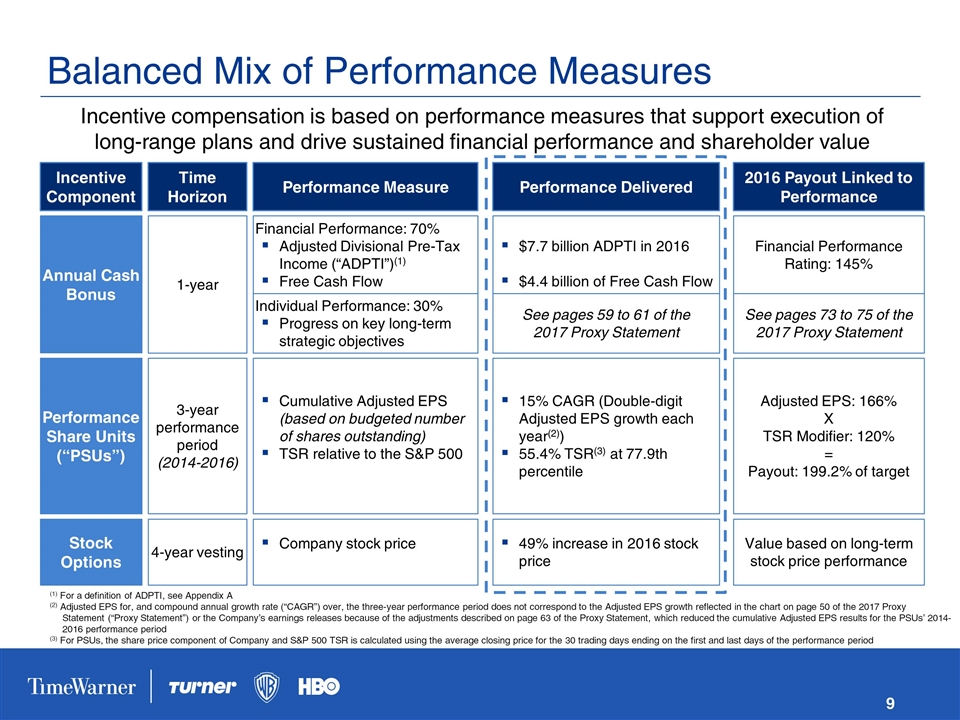
Financial Performance Rating: 145% $7.7 billion ADPTI in 2016 $4.4 billion of Free Cash Flow Financial Performance: 70% Adjusted Divisional Pre-Tax Income (“ADPTI”)(1) Free Cash Flow Balanced Mix of Performance Measures Incentive compensation is based on performance measures that support execution of long-range plans and drive sustained financial performance and shareholder value Incentive Component Time Horizon Performance Measure Performance Delivered 2016 Payout Linked to Performance Annual Cash Bonus Performance Share Units (“PSUs”) Stock Options 1-year 3-year performance period (2014-2016) 4-year vesting Cumulative Adjusted EPS (based on budgeted number of shares outstanding) TSR relative to the S&P 500 Company stock price 49% increase in 2016 stock price 15% CAGR (Double-digit Adjusted EPS growth each year(2)) 55.4% TSR(3) at 77.9th percentile Adjusted EPS: 166% X TSR Modifier: 120% = Payout: 199.2% of target Value based on long-term stock price performance Individual Performance: 30% Progress on key long-term strategic objectives See pages 59 to 61 of the 2017 Proxy Statement See pages 73 to 75 of the 2017 Proxy Statement (1) For a definition of ADPTI, see Appendix A (2) Adjusted EPS for, and compound annual growth rate (“CAGR”) over, the three-year performance period does not correspond to the Adjusted EPS growth reflected in the chart on page 50 of the 2017 Proxy Statement (“Proxy Statement”) or the Company’s earnings releases because of the adjustments described on page 63 of the Proxy Statement, which reduced the cumulative Adjusted EPS results for the PSUs’ 2014-2016 performance period (3) For PSUs, the share price component of Company and S&P 500 TSR is calculated using the average closing price for the 30 trading days ending on the first and last days of the performance period
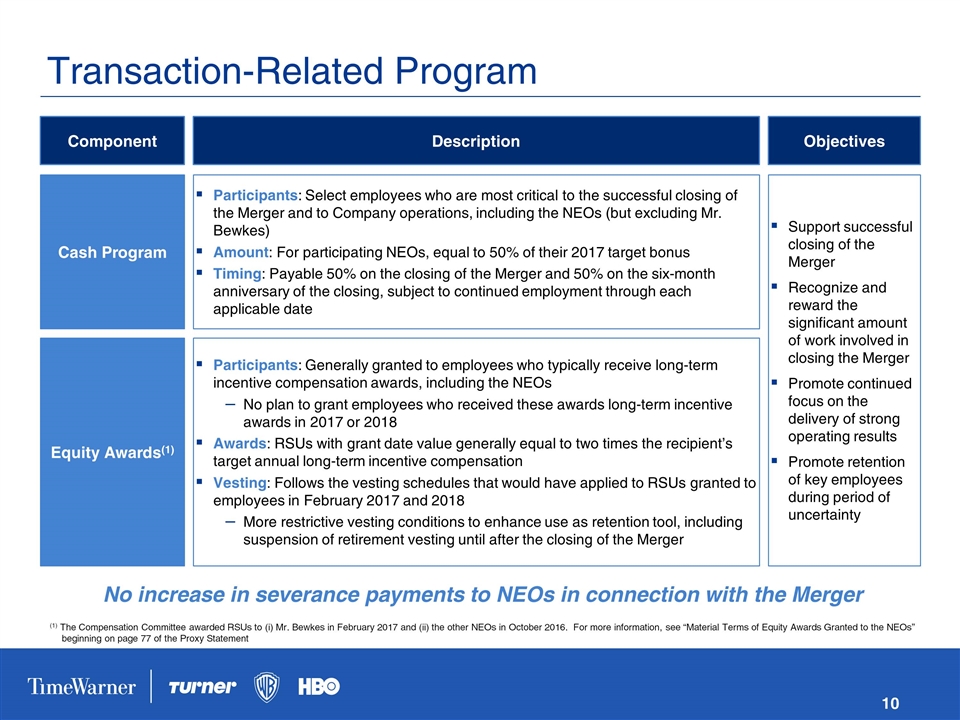
Support successful closing of the Merger Recognize and reward the significant amount of work involved in closing the Merger Promote continued focus on the delivery of strong operating results Promote retention of key employees during period of uncertainty Participants: Select employees who are most critical to the successful closing of the Merger and to Company operations, including the NEOs (but excluding Mr. Bewkes) Amount: For participating NEOs, equal to 50% of their 2017 target bonus Timing: Payable 50% on the closing of the Merger and 50% on the six-month anniversary of the closing, subject to continued employment through each applicable date Transaction-Related Program Component Description Objectives Cash Program Equity Awards(1) Participants: Generally granted to employees who typically receive long-term incentive compensation awards, including the NEOs No plan to grant employees who received these awards long-term incentive awards in 2017 or 2018 Awards: RSUs with grant date value generally equal to two times the recipient’s target annual long-term incentive compensation Vesting: Follows the vesting schedules that would have applied to RSUs granted to employees in February 2017 and 2018 More restrictive vesting conditions to enhance use as retention tool, including suspension of retirement vesting until after the closing of the Merger (1) The Compensation Committee awarded RSUs to (i) Mr. Bewkes in February 2017 and (ii) the other NEOs in October 2016. For more information, see “Material Terms of Equity Awards Granted to the NEOs” beginning on page 77 of the Proxy Statement No increase in severance payments to NEOs in connection with the Merger
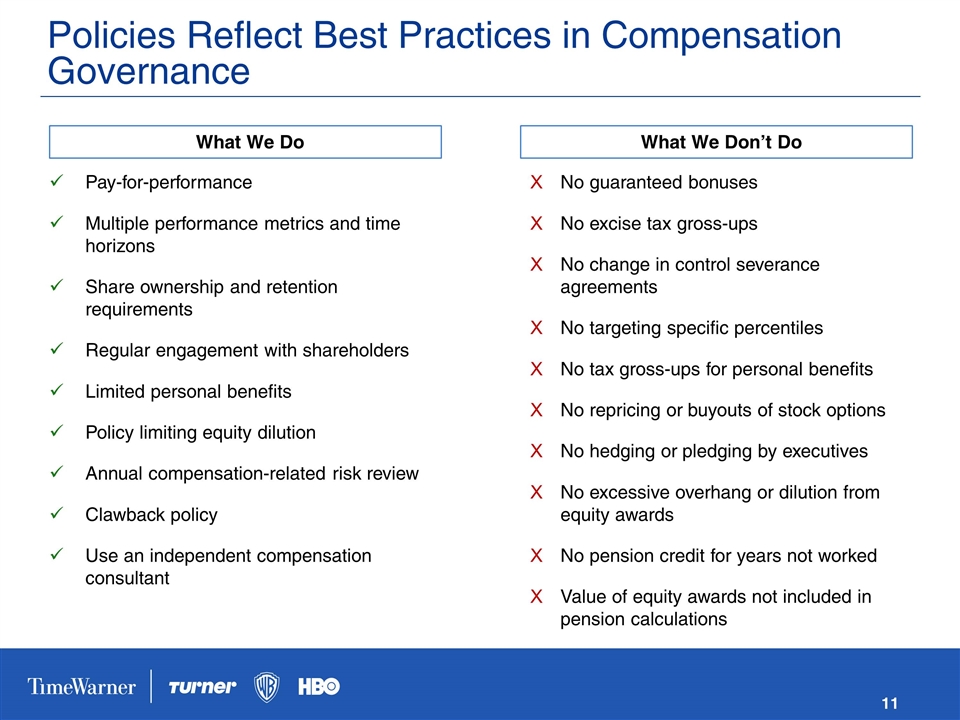
Policies Reflect Best Practices in Compensation Governance Pay-for-performance Multiple performance metrics and time horizons Share ownership and retention requirements Regular engagement with shareholders Limited personal benefits Policy limiting equity dilution Annual compensation-related risk review Clawback policy Use an independent compensation consultant No guaranteed bonuses No excise tax gross-ups No change in control severance agreements No targeting specific percentiles No tax gross-ups for personal benefits No repricing or buyouts of stock options No hedging or pledging by executives No excessive overhang or dilution from equity awards No pension credit for years not worked Value of equity awards not included in pension calculations What We Do What We Don’t Do
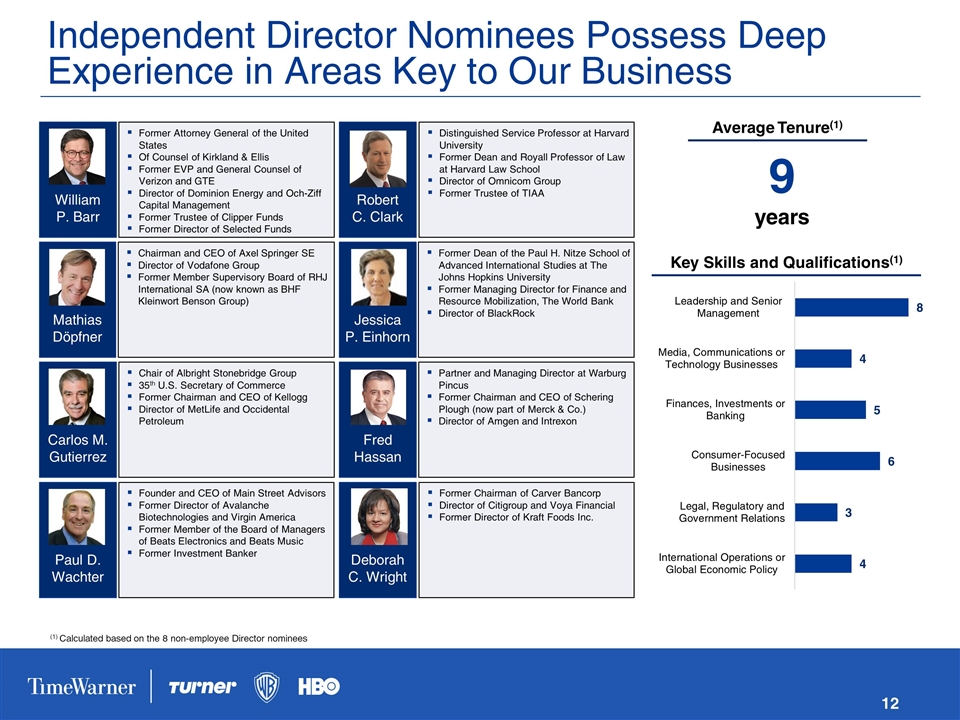
Independent Director Nominees Possess Deep Experience in Areas Key to Our Business Key Skills and Qualifications(1) 9 years Average Tenure(1) (1) Calculated based on the 8 non-employee Director nominees William P. Barr Former Attorney General of the United States Of Counsel of Kirkland & Ellis Former EVP and General Counsel of Verizon and GTE Director of Dominion Energy and Och-Ziff Capital Management Former Trustee of Clipper Funds Former Director of Selected Funds Robert C. Clark Distinguished Service Professor at Harvard University Former Dean and Royall Professor of Law at Harvard Law School Director of Omnicom Group Former Trustee of TIAA Chairman and CEO of Axel Springer SE Director of Vodafone Group Former Member Supervisory Board of RHJ International SA (now known as BHF Kleinwort Benson Group) Mathias Döpfner Jessica P. Einhorn Former Dean of the Paul H. Nitze School of Advanced International Studies at The Johns Hopkins University Former Managing Director for Finance and Resource Mobilization, The World Bank Director of BlackRock Carlos M. Gutierrez Chair of Albright Stonebridge Group 35th U.S. Secretary of Commerce Former Chairman and CEO of Kellogg Director of MetLife and Occidental Petroleum Partner and Managing Director at Warburg Pincus Former Chairman and CEO of Schering Plough (now part of Merck & Co.) Director of Amgen and Intrexon Fred Hassan Paul D. Wachter Founder and CEO of Main Street Advisors Former Director of Avalanche Biotechnologies and Virgin America Former Member of the Board of Managers of Beats Electronics and Beats Music Former Investment Banker Deborah C. Wright Former Chairman of Carver Bancorp Director of Citigroup and Voya Financial Former Director of Kraft Foods Inc.
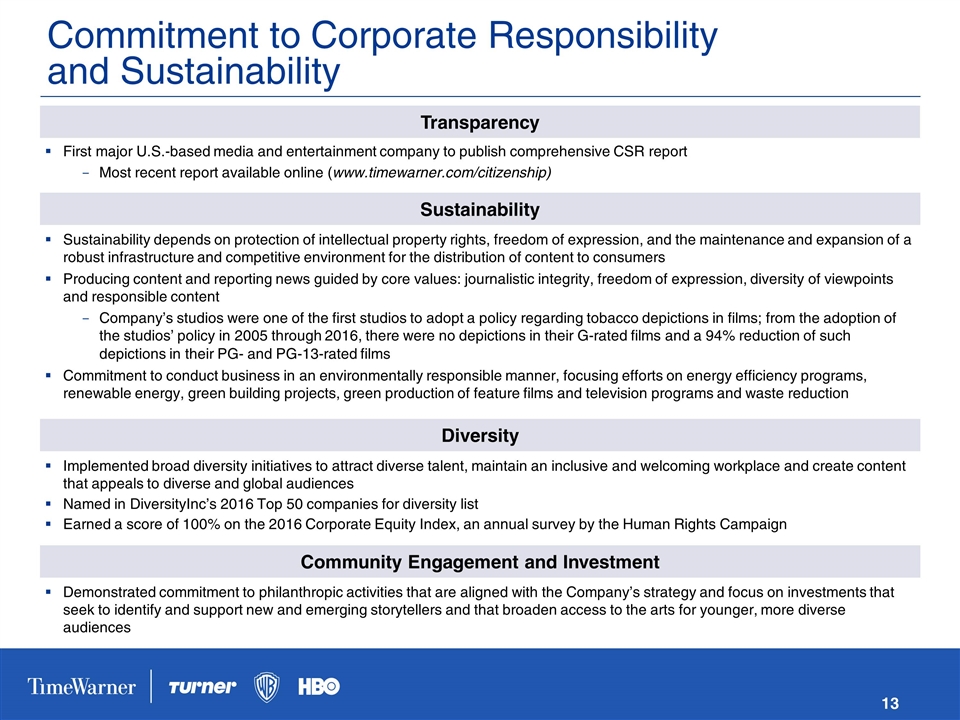
Commitment to Corporate Responsibility and Sustainability Transparency First major U.S.-based media and entertainment company to publish comprehensive CSR report Most recent report available online (www.timewarner.com/citizenship) Sustainability Sustainability depends on protection of intellectual property rights, freedom of expression, and the maintenance and expansion of a robust infrastructure and competitive environment for the distribution of content to consumers Producing content and reporting news guided by core values: journalistic integrity, freedom of expression, diversity of viewpoints and responsible content Company’s studios were one of the first studios to adopt a policy regarding tobacco depictions in films; from the adoption of the studios’ policy in 2005 through 2016, there were no depictions in their G-rated films and a 94% reduction of such depictions in their PG- and PG-13-rated films Commitment to conduct business in an environmentally responsible manner, focusing efforts on energy efficiency programs, renewable energy, green building projects, green production of feature films and television programs and waste reduction Diversity Implemented broad diversity initiatives to attract diverse talent, maintain an inclusive and welcoming workplace and create content that appeals to diverse and global audiences Named in DiversityInc’s 2016 Top 50 companies for diversity list Earned a score of 100% on the 2016 Corporate Equity Index, an annual survey by the Human Rights Campaign Community Engagement and Investment Demonstrated commitment to philanthropic activities that are aligned with the Company’s strategy and focus on investments that seek to identify and support new and emerging storytellers and that broaden access to the arts for younger, more diverse audiences
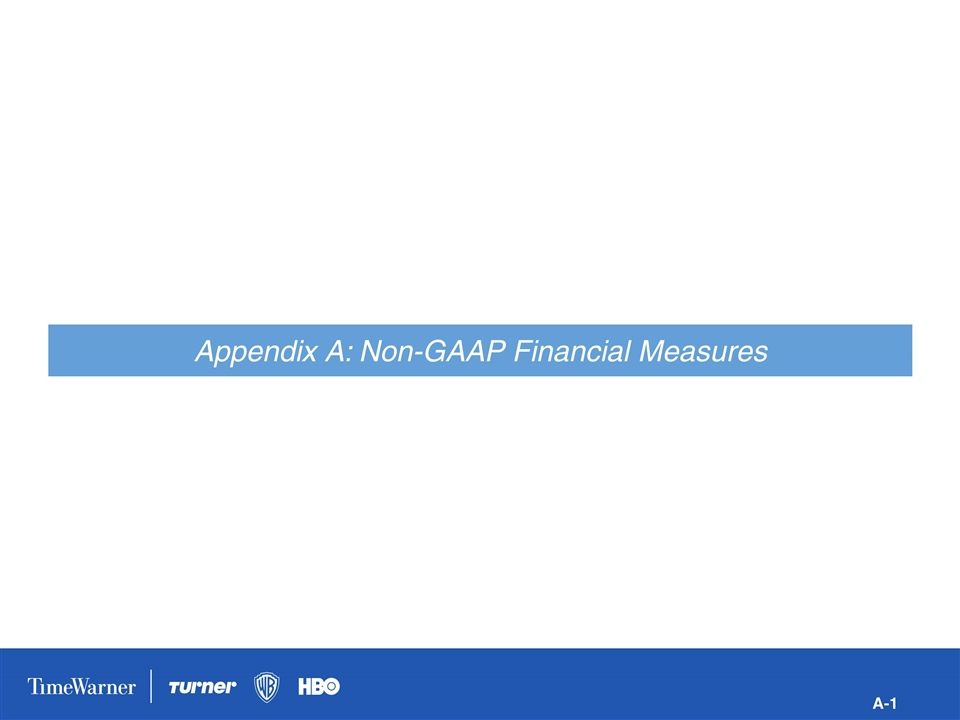
Appendix A: Non-GAAP Financial Measures A-1
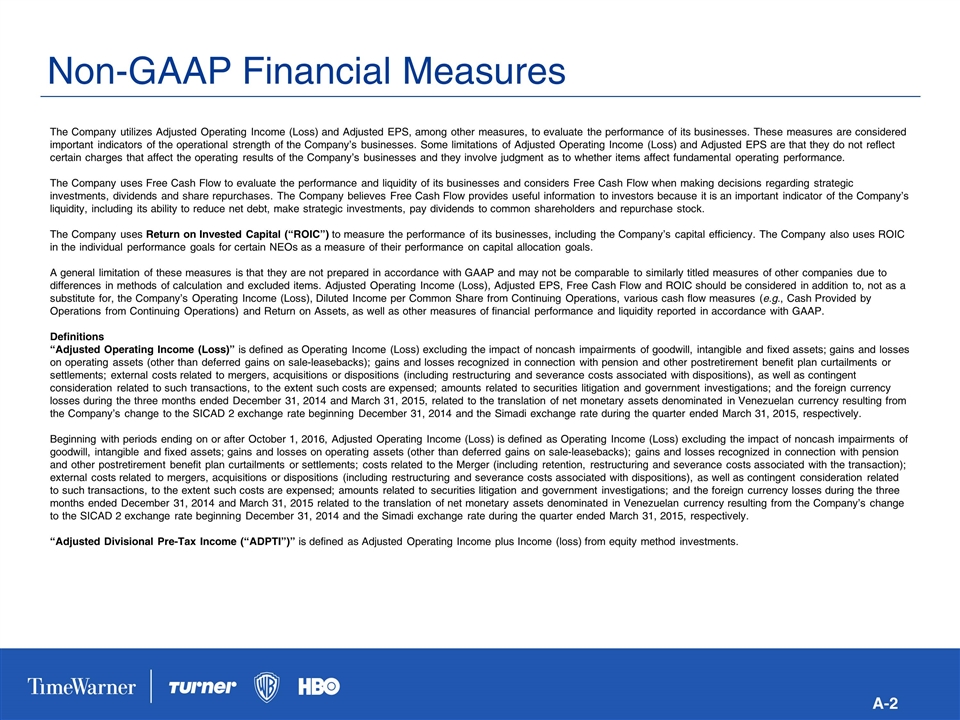
A-2 The Company utilizes Adjusted Operating Income (Loss) and Adjusted EPS, among other measures, to evaluate the performance of its businesses. These measures are considered important indicators of the operational strength of the Company’s businesses. Some limitations of Adjusted Operating Income (Loss) and Adjusted EPS are that they do not reflect certain charges that affect the operating results of the Company’s businesses and they involve judgment as to whether items affect fundamental operating performance. The Company uses Free Cash Flow to evaluate the performance and liquidity of its businesses and considers Free Cash Flow when making decisions regarding strategic investments, dividends and share repurchases. The Company believes Free Cash Flow provides useful information to investors because it is an important indicator of the Company’s liquidity, including its ability to reduce net debt, make strategic investments, pay dividends to common shareholders and repurchase stock. The Company uses Return on Invested Capital (“ROIC”) to measure the performance of its businesses, including the Company’s capital efficiency. The Company also uses ROIC in the individual performance goals for certain NEOs as a measure of their performance on capital allocation goals. A general limitation of these measures is that they are not prepared in accordance with GAAP and may not be comparable to similarly titled measures of other companies due to differences in methods of calculation and excluded items. Adjusted Operating Income (Loss), Adjusted EPS, Free Cash Flow and ROIC should be considered in addition to, not as a substitute for, the Company’s Operating Income (Loss), Diluted Income per Common Share from Continuing Operations, various cash flow measures (e.g., Cash Provided by Operations from Continuing Operations) and Return on Assets, as well as other measures of financial performance and liquidity reported in accordance with GAAP. Definitions “Adjusted Operating Income (Loss)” is defined as Operating Income (Loss) excluding the impact of noncash impairments of goodwill, intangible and fixed assets; gains and losses on operating assets (other than deferred gains on sale-leasebacks); gains and losses recognized in connection with pension and other postretirement benefit plan curtailments or settlements; external costs related to mergers, acquisitions or dispositions (including restructuring and severance costs associated with dispositions), as well as contingent consideration related to such transactions, to the extent such costs are expensed; amounts related to securities litigation and government investigations; and the foreign currency losses during the three months ended December 31, 2014 and March 31, 2015, related to the translation of net monetary assets denominated in Venezuelan currency resulting from the Company’s change to the SICAD 2 exchange rate beginning December 31, 2014 and the Simadi exchange rate during the quarter ended March 31, 2015, respectively. Beginning with periods ending on or after October 1, 2016, Adjusted Operating Income (Loss) is defined as Operating Income (Loss) excluding the impact of noncash impairments of goodwill, intangible and fixed assets; gains and losses on operating assets (other than deferred gains on sale-leasebacks); gains and losses recognized in connection with pension and other postretirement benefit plan curtailments or settlements; costs related to the Merger (including retention, restructuring and severance costs associated with the transaction); external costs related to mergers, acquisitions or dispositions (including restructuring and severance costs associated with dispositions), as well as contingent consideration related to such transactions, to the extent such costs are expensed; amounts related to securities litigation and government investigations; and the foreign currency losses during the three months ended December 31, 2014 and March 31, 2015 related to the translation of net monetary assets denominated in Venezuelan currency resulting from the Company’s change to the SICAD 2 exchange rate beginning December 31, 2014 and the Simadi exchange rate during the quarter ended March 31, 2015, respectively. “Adjusted Divisional Pre-Tax Income (“ADPTI”)” is defined as Adjusted Operating Income plus Income (loss) from equity method investments. Non-GAAP Financial Measures
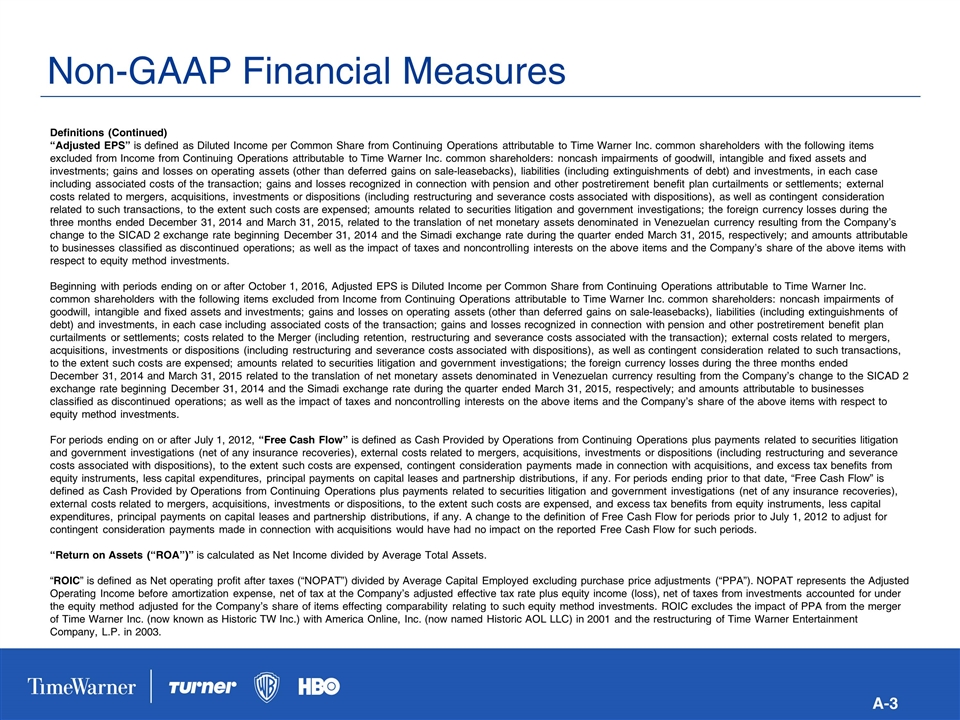
A-3 Definitions (Continued) “Adjusted EPS” is defined as Diluted Income per Common Share from Continuing Operations attributable to Time Warner Inc. common shareholders with the following items excluded from Income from Continuing Operations attributable to Time Warner Inc. common shareholders: noncash impairments of goodwill, intangible and fixed assets and investments; gains and losses on operating assets (other than deferred gains on sale-leasebacks), liabilities (including extinguishments of debt) and investments, in each case including associated costs of the transaction; gains and losses recognized in connection with pension and other postretirement benefit plan curtailments or settlements; external costs related to mergers, acquisitions, investments or dispositions (including restructuring and severance costs associated with dispositions), as well as contingent consideration related to such transactions, to the extent such costs are expensed; amounts related to securities litigation and government investigations; the foreign currency losses during the three months ended December 31, 2014 and March 31, 2015, related to the translation of net monetary assets denominated in Venezuelan currency resulting from the Company’s change to the SICAD 2 exchange rate beginning December 31, 2014 and the Simadi exchange rate during the quarter ended March 31, 2015, respectively; and amounts attributable to businesses classified as discontinued operations; as well as the impact of taxes and noncontrolling interests on the above items and the Company’s share of the above items with respect to equity method investments. Beginning with periods ending on or after October 1, 2016, Adjusted EPS is Diluted Income per Common Share from Continuing Operations attributable to Time Warner Inc. common shareholders with the following items excluded from Income from Continuing Operations attributable to Time Warner Inc. common shareholders: noncash impairments of goodwill, intangible and fixed assets and investments; gains and losses on operating assets (other than deferred gains on sale-leasebacks), liabilities (including extinguishments of debt) and investments, in each case including associated costs of the transaction; gains and losses recognized in connection with pension and other postretirement benefit plan curtailments or settlements; costs related to the Merger (including retention, restructuring and severance costs associated with the transaction); external costs related to mergers, acquisitions, investments or dispositions (including restructuring and severance costs associated with dispositions), as well as contingent consideration related to such transactions, to the extent such costs are expensed; amounts related to securities litigation and government investigations; the foreign currency losses during the three months ended December 31, 2014 and March 31, 2015 related to the translation of net monetary assets denominated in Venezuelan currency resulting from the Company’s change to the SICAD 2 exchange rate beginning December 31, 2014 and the Simadi exchange rate during the quarter ended March 31, 2015, respectively; and amounts attributable to businesses classified as discontinued operations; as well as the impact of taxes and noncontrolling interests on the above items and the Company’s share of the above items with respect to equity method investments. For periods ending on or after July 1, 2012, “Free Cash Flow” is defined as Cash Provided by Operations from Continuing Operations plus payments related to securities litigation and government investigations (net of any insurance recoveries), external costs related to mergers, acquisitions, investments or dispositions (including restructuring and severance costs associated with dispositions), to the extent such costs are expensed, contingent consideration payments made in connection with acquisitions, and excess tax benefits from equity instruments, less capital expenditures, principal payments on capital leases and partnership distributions, if any. For periods ending prior to that date, “Free Cash Flow” is defined as Cash Provided by Operations from Continuing Operations plus payments related to securities litigation and government investigations (net of any insurance recoveries), external costs related to mergers, acquisitions, investments or dispositions, to the extent such costs are expensed, and excess tax benefits from equity instruments, less capital expenditures, principal payments on capital leases and partnership distributions, if any. A change to the definition of Free Cash Flow for periods prior to July 1, 2012 to adjust for contingent consideration payments made in connection with acquisitions would have had no impact on the reported Free Cash Flow for such periods. “Return on Assets (“ROA”)” is calculated as Net Income divided by Average Total Assets. “ROIC” is defined as Net operating profit after taxes (“NOPAT”) divided by Average Capital Employed excluding purchase price adjustments (“PPA”). NOPAT represents the Adjusted Operating Income before amortization expense, net of tax at the Company’s adjusted effective tax rate plus equity income (loss), net of taxes from investments accounted for under the equity method adjusted for the Company’s share of items effecting comparability relating to such equity method investments. ROIC excludes the impact of PPA from the merger of Time Warner Inc. (now known as Historic TW Inc.) with America Online, Inc. (now named Historic AOL LLC) in 2001 and the restructuring of Time Warner Entertainment Company, L.P. in 2003. Non-GAAP Financial Measures
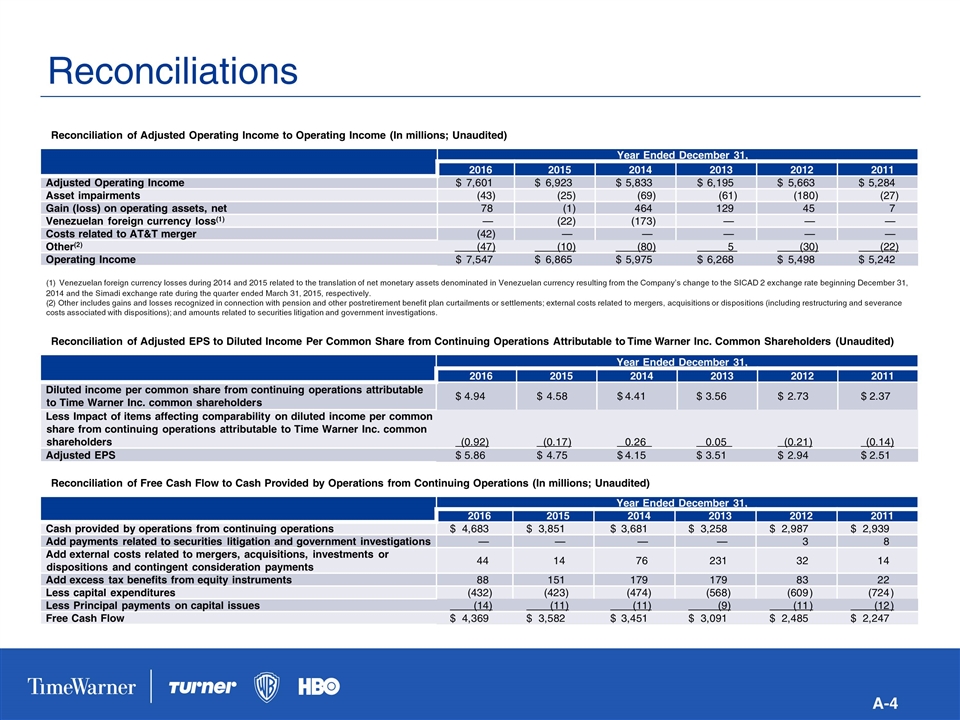
A-4 Reconciliations Year Ended December 31, 2016 2015 2014 2013 2012 2011 Adjusted Operating Income $7,601 $6,923 $5,833 $6,195 $5,663 $5,284 Asset impairments (43) (25) (69) (61) (180) (27) Gain (loss) on operating assets, net 78 (1) 464 129 45 7 Venezuelan foreign currency loss(1) — (22) (173) — — — Costs related to AT&T merger (42) — — — — — Other(2) (47) (10) (80) 5 (30) (22) Operating Income $7,547 $6,865 $5,975 $6,268 $5,498 $5,242 Reconciliation of Adjusted Operating Income to Operating Income (In millions; Unaudited) (1) Venezuelan foreign currency losses during 2014 and 2015 related to the translation of net monetary assets denominated in Venezuelan currency resulting from the Company’s change to the SICAD 2 exchange rate beginning December 31, 2014 and the Simadi exchange rate during the quarter ended March 31, 2015, respectively. (2) Other includes gains and losses recognized in connection with pension and other postretirement benefit plan curtailments or settlements; external costs related to mergers, acquisitions or dispositions (including restructuring and severance costs associated with dispositions); and amounts related to securities litigation and government investigations. Reconciliation of Adjusted EPS to Diluted Income Per Common Share from Continuing Operations Attributable to Time Warner Inc. Common Shareholders (Unaudited) Year Ended December 31, 2016 2015 2014 2013 2012 2011 Diluted income per common share from continuing operations attributable to Time Warner Inc. common shareholders $4.94 $4.58 $4.41 $3.56 $2.73 $2.37 Less Impact of items affecting comparability on diluted income per common share from continuing operations attributable to Time Warner Inc. common shareholders (0.92) (0.17) 0.26 0.05 (0.21) (0.14) Adjusted EPS $5.86 $4.75 $4.15 $3.51 $2.94 $2.51 Reconciliation of Free Cash Flow to Cash Provided by Operations from Continuing Operations (In millions; Unaudited) Year Ended December 31, 2016 2015 2014 2013 2012 2011 Cash provided by operations from continuing operations $4,683 $3,851 $3,681 $3,258 $2,987 $2,939 Add payments related to securities litigation and government investigations — — — — 3 8 Add external costs related to mergers, acquisitions, investments or dispositions and contingent consideration payments 44 14 76 231 32 14 Add excess tax benefits from equity instruments 88 151 179 179 83 22 Less capital expenditures (432) (423) (474) (568) (609) (724) Less Principal payments on capital issues (14) (11) (11) (9) (11) (12) Free Cash Flow $4,369 $3,582 $3,451 $3,091 $2,485 $2,247
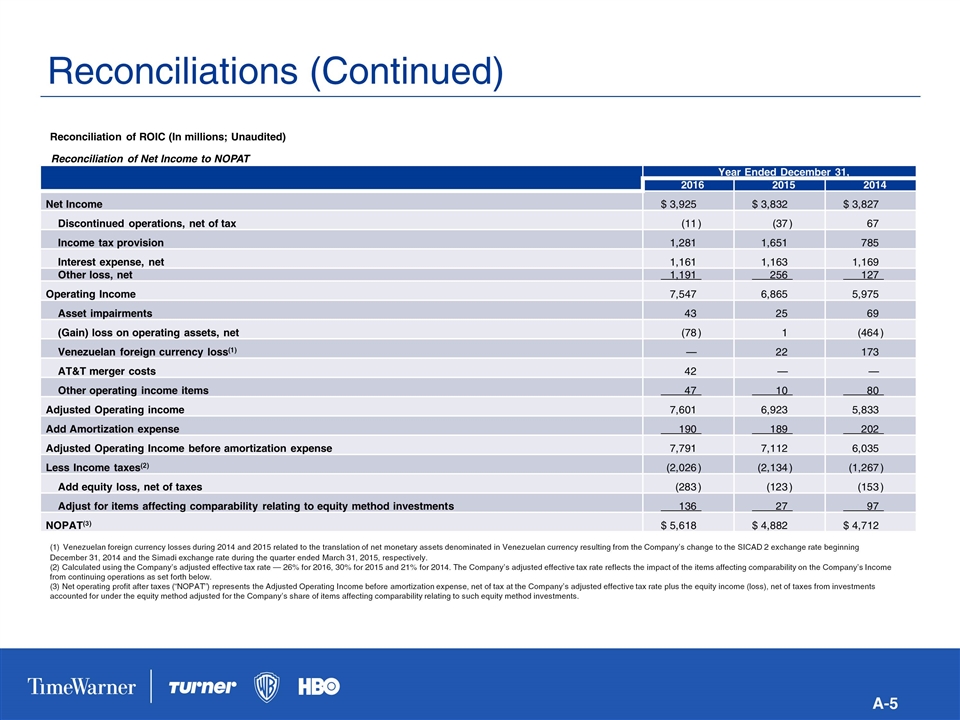
A-5 Reconciliations (Continued) Reconciliation of ROIC (In millions; Unaudited) Year Ended December 31, 2016 2015 2014 Net Income $3,925 $3,832 $3,827 Discontinued operations, net of tax (11) (37) 67 Income tax provision 1,281 1,651 785 Interest expense, net 1,161 1,163 1,169 Other loss, net 1,191 256 127 Operating Income 7,547 6,865 5,975 Asset impairments 43 25 69 (Gain) loss on operating assets, net (78) 1 (464) Venezuelan foreign currency loss(1) — 22 173 AT&T merger costs 42 — — Other operating income items 47 10 80 Adjusted Operating income 7,601 6,923 5,833 Add Amortization expense 190 189 202 Adjusted Operating Income before amortization expense 7,791 7,112 6,035 Less Income taxes(2) (2,026) (2,134) (1,267) Add equity loss, net of taxes (283) (123) (153) Adjust for items affecting comparability relating to equity method investments 136 27 97 NOPAT(3) $5,618 $4,882 $4,712 Reconciliation of Net Income to NOPAT (1) Venezuelan foreign currency losses during 2014 and 2015 related to the translation of net monetary assets denominated in Venezuelan currency resulting from the Company’s change to the SICAD 2 exchange rate beginning December 31, 2014 and the Simadi exchange rate during the quarter ended March 31, 2015, respectively. (2) Calculated using the Company’s adjusted effective tax rate — 26% for 2016, 30% for 2015 and 21% for 2014. The Company’s adjusted effective tax rate reflects the impact of the items affecting comparability on the Company’s Income from continuing operations as set forth below. (3) Net operating profit after taxes (“NOPAT”) represents the Adjusted Operating Income before amortization expense, net of tax at the Company’s adjusted effective tax rate plus the equity income (loss), net of taxes from investments accounted for under the equity method adjusted for the Company’s share of items affecting comparability relating to such equity method investments.
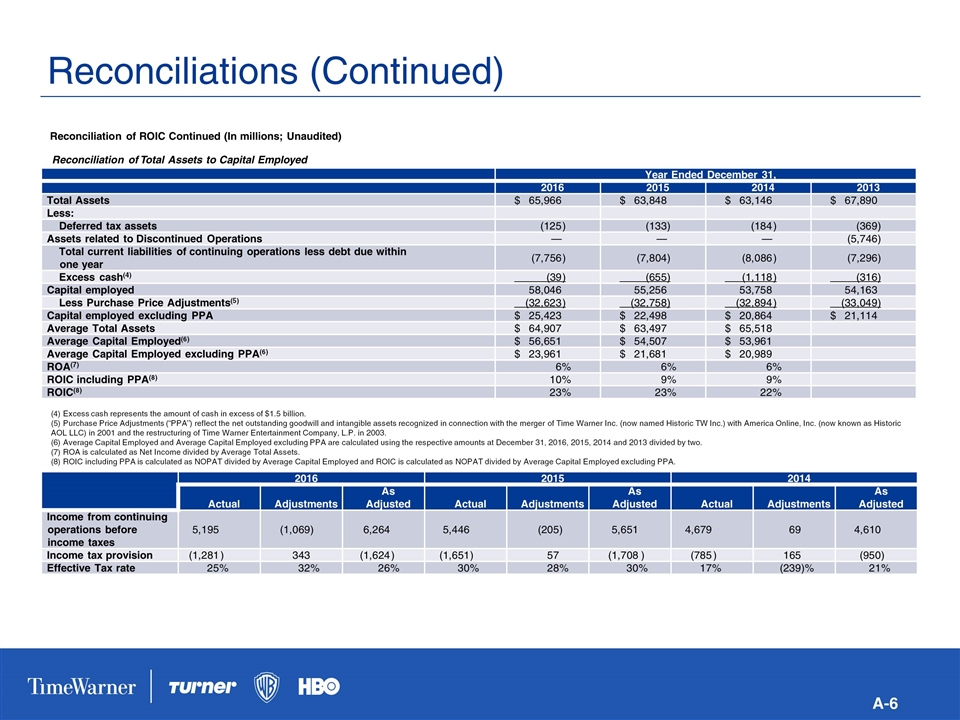
A-6 Reconciliations (Continued) Reconciliation of ROIC Continued (In millions; Unaudited) Reconciliation of Total Assets to Capital Employed Year Ended December 31, 2016 2015 2014 2013 Total Assets $65,966 $63,848 $63,146 $67,890 Less: Deferred tax assets (125) (133) (184) (369) Assets related to Discontinued Operations — — — (5,746) Total current liabilities of continuing operations less debt due within one year (7,756) (7,804) (8,086) (7,296) Excess cash(4) (39) (655) (1,118) (316) Capital employed 58,046 55,256 53,758 54,163 Less Purchase Price Adjustments(5) (32,623) (32,758) (32,894) (33,049) Capital employed excluding PPA $25,423 $22,498 $20,864 $21,114 Average Total Assets $64,907 $63,497 $65,518 Average Capital Employed(6) $56,651 $54,507 $53,961 Average Capital Employed excluding PPA(6) $23,961 $21,681 $20,989 ROA(7) 6% 6% 6% ROIC including PPA(8) 10% 9% 9% ROIC(8) 23% 23% 22% 2016 2015 2014 Actual Adjustments As Adjusted Actual Adjustments As Adjusted Actual Adjustments As Adjusted Income from continuing operations before income taxes 5,195 (1,069) 6,264 5,446 (205) 5,651 4,679 69 4,610 Income tax provision (1,281) 343 (1,624) (1,651) 57 (1,708) (785) 165 (950) Effective Tax rate 25% 32% 26% 30% 28% 30% 17% (239)% 21% (4) Excess cash represents the amount of cash in excess of $1.5 billion. (5) Purchase Price Adjustments (“PPA”) reflect the net outstanding goodwill and intangible assets recognized in connection with the merger of Time Warner Inc. (now named Historic TW Inc.) with America Online, Inc. (now known as Historic AOL LLC) in 2001 and the restructuring of Time Warner Entertainment Company, L.P. in 2003. (6) Average Capital Employed and Average Capital Employed excluding PPA are calculated using the respective amounts at December 31, 2016, 2015, 2014 and 2013 divided by two. (7) ROA is calculated as Net Income divided by Average Total Assets. (8) ROIC including PPA is calculated as NOPAT divided by Average Capital Employed and ROIC is calculated as NOPAT divided by Average Capital Employed excluding PPA.
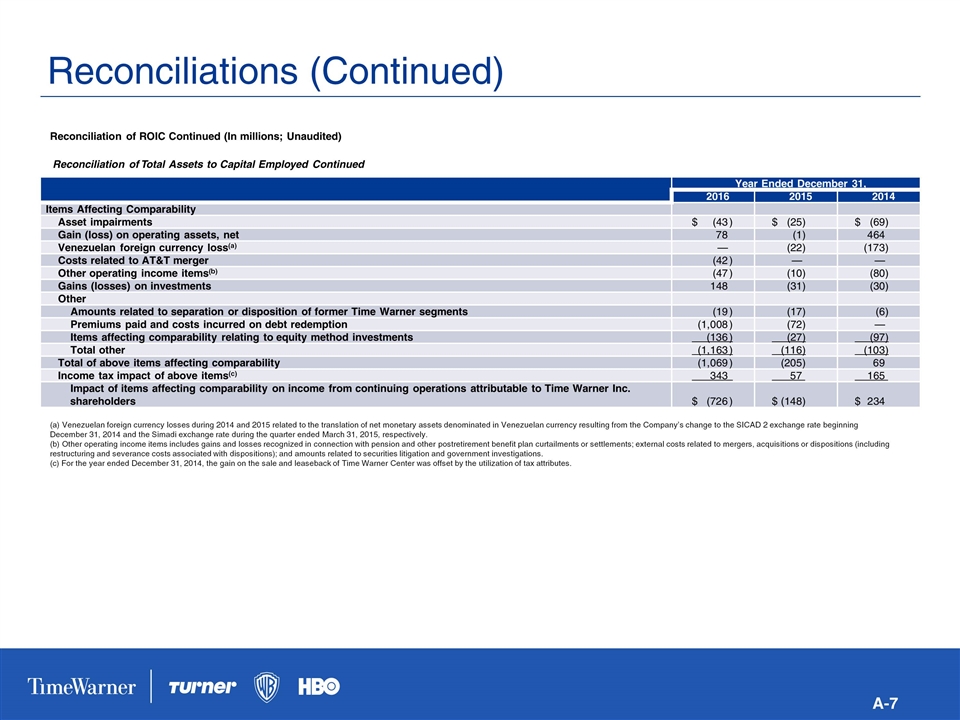
A-7 Reconciliations (Continued) Reconciliation of ROIC Continued (In millions; Unaudited) Reconciliation of Total Assets to Capital Employed Continued Year Ended December 31, 2016 2015 2014 Items Affecting Comparability Asset impairments $(43) $(25) $(69) Gain (loss) on operating assets, net 78 (1) 464 Venezuelan foreign currency loss(a) — (22) (173) Costs related to AT&T merger (42) — — Other operating income items(b) (47) (10) (80) Gains (losses) on investments 148 (31) (30) Other Amounts related to separation or disposition of former Time Warner segments (19) (17) (6) Premiums paid and costs incurred on debt redemption (1,008) (72) — Items affecting comparability relating to equity method investments (136) (27) (97) Total other (1,163) (116) (103) Total of above items affecting comparability (1,069) (205) 69 Income tax impact of above items(c) 343 57 165 Impact of items affecting comparability on income from continuing operations attributable to Time Warner Inc. shareholders $(726) $(148) $234 (a) Venezuelan foreign currency losses during 2014 and 2015 related to the translation of net monetary assets denominated in Venezuelan currency resulting from the Company’s change to the SICAD 2 exchange rate beginning December 31, 2014 and the Simadi exchange rate during the quarter ended March 31, 2015, respectively. (b) Other operating income items includes gains and losses recognized in connection with pension and other postretirement benefit plan curtailments or settlements; external costs related to mergers, acquisitions or dispositions (including restructuring and severance costs associated with dispositions); and amounts related to securities litigation and government investigations. (c) For the year ended December 31, 2014, the gain on the sale and leaseback of Time Warner Center was offset by the utilization of tax attributes.



















